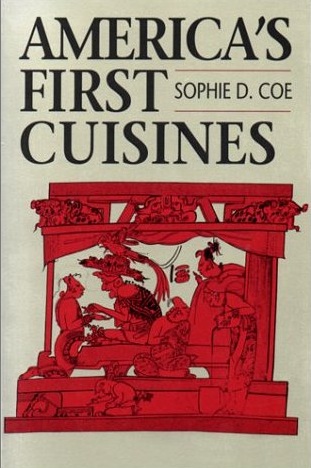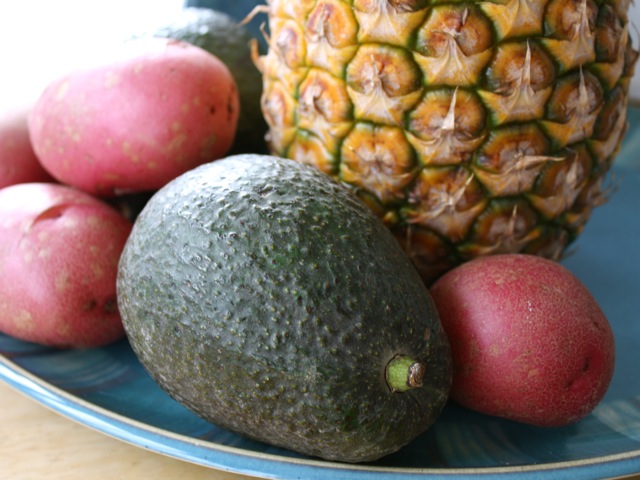
reference-image, l
(article, Sophie D. Coe)
[%pageBreakSettings nobreak=true][%adInjectionSettings noInject=true] h3. From Chapter 3: New World Produce The New World offers a veritable cornucopia of fruits and vegetables to the hungry. From this abundance of "produce" (a handy term which avoids the question of what is a fruit and what is a vegetable, a distinction founded on culinary culture and not on botany), the modern world has selected a few and left the rest to languish in their native hills and valleys. What led certain plant foods to be accepted by the Europeans and the modern world, while others were rejected? Four factors seem to have led to certain plants finding favor, given that they were basically amenable and willing to grow and produce with reasonable ease and speed and could adapt to more than a single specialized environment. [[block(sidebar). h1. About the book and author America's First Cuisines is a classic work of culinary history by the late anthropologist Sophie D. Coe. Focused on the Aztecs, Maya, and Inca, the book draws on original Spanish and Native American sources to describe and interpret what the inhabitants of the New World ate and drank at the time of the Spanish conquest. Excerpted with permission from the University of Texas Press, copyright © 1994. ]] The first class of acceptable plants were those which fit nicely into already established European categories. Maize should be included here, although attaining due respect as the culinary equal of wheat took centuries. Father Serra, the 18th-century Franciscan missionary, illustrates the difficulties individuals newly arrived in the New World had with nonwheat bread almost 300 years after Columbus: bq. At midday they brought us a meal of stewed and roast fowl. They brought arepas \[thick maize tortillas\], roast plantains, sweet manioc, sweet potatoes, etc. But we did not know how to eat without bread. Then I realized that bread was sustenance to someone who was brought up like me, and I remembered that when I was in Cadíz about to leave, a brother said to me, "Brother John, you are going to the Indies: God keep you from losing sight of bread." Other foods which meshed with pre-existing European food categories were the New World beans. They looked, cooked, and tasted like the pulses which were on every Spanish ship's manifest. The Old World habas, garbanzos, and lentejas translate into English as broad beans, chickpeas, and lentils, and into botanical Latin as Vicia faba, Cicer arietinum, and Lens esculenta. The New World Phaseolus beans not only could be used like the Old World ones but also were related to them, all being members of the family Leguminosae, subfamily Papilionoideae. Two other plants won acceptance because they could replace almonds in marzipan, which was then an elegant and expensive dish and loaded with prestige. Both the peanut (Arachis hypogaea) and the hulled seeds of the genus Cucurbita squashes could be toasted, ground, mixed with sugar or honey and some egg white, and then dried in the oven. This dough could be molded into different shapes and then gilded, silvered, or tinted according to the whim of the creator. (In the next-to-last chapter we shall see it appearing on the tables of the great in early colonial Mexico City.) The parts of the squash that we eat now — the flowers, the shoots, and the immature or ripe fruit — were scorned as belonging to the category of greens; that is to say, poor people's food. [%image feature-image float=right width=400 caption="Early European explorers in the New World approved of potatoes, avocadoes, and pineapple."] Even if food plants did not fit into a convenient European niche, some of them possessed unique qualities which led to their enthusiastic embrace by the Europeans. The pineapple (Ananas comosus) was taken back to the Old World very soon after the discovery. The fruit was sufficiently resistant to shipping so that some survived the trip unrotted, and astounded the savants with their fragrance. Although avocadoes were not such good travelers and only spread through the culinary world in the 20th century, their unctuous oily flesh — a trait shared only with the olive and the coconut in the edible-plant world — intrigued the natural-history writers enough to be given long chapters in their books on the vegetable wonders of the New World. As a peculiar form of endorsement, the avocado was stripped of its perfectly good etymology in Nahuatl, the language of the Aztecs, where the word derives from ahuacatl, or testicle. The Oxford English Dictionary ignores this completely and claims that the word comes from "advocate," or lawyer. How lawyers could have become involved with the fruit of Persea americana is nowhere explained; one can only suggest that it is from the tendency of the legal profession to insert itself everywhere. The third category of welcomed foods has already been encountered. These are the plant foods that may not have had instant appeal for reasons of taste, but were cheap, efficient, and hugely productive sources of calories. Manioc and potatoes belong in this category. After the discovery of the silver mines of Potosí in Peru in 1545, fortunes were made by Europeans who produced chuño, a pre-Columbian invention of storable freeze-dried potatoes, to feed the Indian miners imprisoned in the dark galleries. The use of manioc to make military stores has already been mentioned. Finally, there is the fourth class of New World foods, which could be referred to as sleepers. The tomato barely received a word in the early writings. If mentioned at all, it was as an ingredient that gave a pleasing sourness to stews. There were fears that it might be poisonous, because of poisonous relatives in the family and the rank odor of the plants. It was also difficult to get it to fruit in places with a short growing season. But with time, the tomato surmounted all these impediments and conquered the culinary universe. Today the food of the world is overwhelmed by this red tide.

reference-image, l

feature-image, l

featurette-image, l

promo-image, l